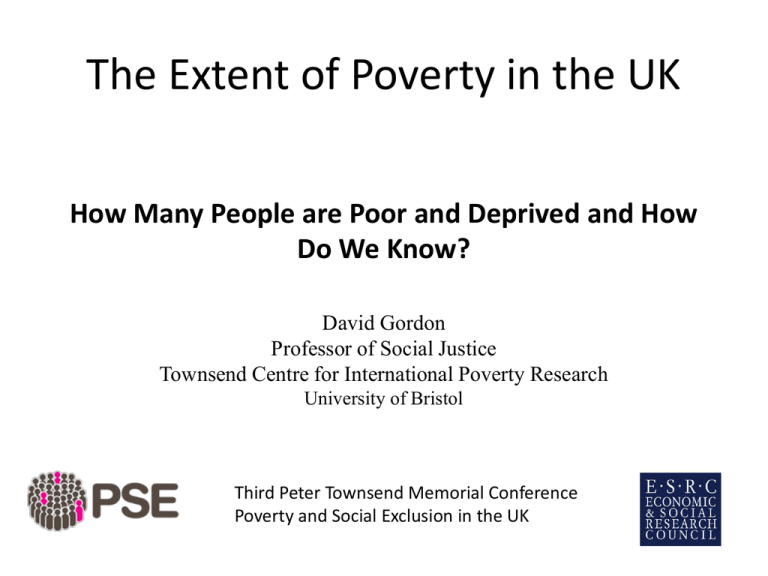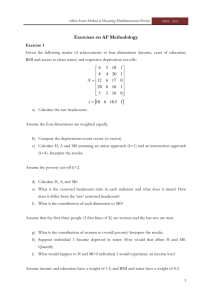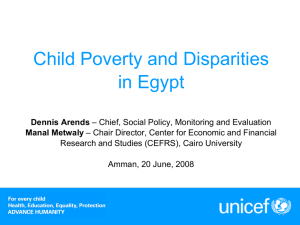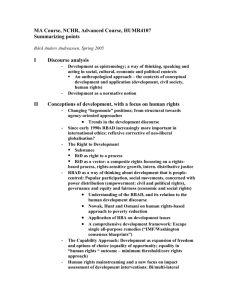slides as powerpoint - Poverty and Social Exclusion
advertisement

The Extent of Poverty in the UK How Many People are Poor and Deprived and How Do We Know? David Gordon Professor of Social Justice Townsend Centre for International Poverty Research University of Bristol Third Peter Townsend Memorial Conference Poverty and Social Exclusion in the UK PSEUK Headline findings Almost 18 million people cannot afford adequate housing conditions; 12 million people are too poor to engage in common social activities; one in three people cannot afford to heat their homes adequately in the winter and four million children and adults aren’t properly fed by today’s standards. One in every six (17 per cent) adults in paid work are poor The percentage of households who fall below society’s minimum standard of living has increased from 14 per cent to 33 per cent over the last 30 years, despite the size of the economy doubling. Hunger in the UK There is widespread public agreement on what constitutes a minimally acceptable diet. Over 90% agree that, for children, this means: three meals a day; fresh fruit and vegetables; and meat, fish or a vegetarian equivalent at least once a day. Yet well over half a million children live in families who cannot afford to feed them properly. ‘I go without for the children so they have proper meals. I can live on one meal a day.’ Jennie, single parent of 3 children Our research shows that, in households where children go without one or more of these basic food necessities: In 93% at least one adult skimp on their own food ‘sometimes’ or ‘often’ to ensure others have enough to eat. Drawing the Poverty Line Townsend’s Scientific Definitions of Poverty Poverty can be defined as; Command over insufficient resources over time The result of poverty is deprivation Modal Deprivation by Logarithm of Income as a Percentage of Supplementary Benefit Scale Rates (Townsend, 1979) Definition of poverty Not Poor Standard of Living Poor High Poverty Threshold Set Too High Optimal Position of the Poverty Threshold Poverty Threshold Set Too Low Low Low Income Income High Income Peter Townsend’s concept of dynamic poverty “poverty is a dynamic, not a static concept…Our general theory, then, should be that individuals and families whose resources over time fall seriously short of the resources commanded by the average individual or family in the community in which they live . . . are in poverty.” Townsend (1962, p 219) Theoretical model of the dynamics of poverty in rich societies Income and Standard of Living Income Standard of Living High Not Poor Not Poor Sinking into poverty Poverty Threshold Climbing out of poverty Poor Low 0 1 2 3 Time 4 5 Poverty Groups Poverty Rate in the UK (PSEUK 2012 Survey) % Poor Rising Vulnerable Not Poor 22 1 10 67 Subjective poverty in the UK (2012) % Household income needed to avoid poverty Above that level of income About the same Below that level of income 54 21 25 Felt embarrassed because of low income Yes No 22 77 Measuring Deprivation Primary Analytical Aim To identify one optimal deprivation index with age and gender appropriate measures to allow comparisons of living standards between and within households – a single all persons deprivation index (age 0 to 80+) Each deprivation measure needs to be; 1. Widely approved (50+% - democratic/consensual threshold) 2. Valid 3. Reliable 4. Additive Widely Approved – More than 50% consider the item/activity to be a necessity Validity – Logistic Regression of each deprivation indicator by Subjective Poverty (3 measures) and General Health (controlling for age & gender) Reliability – Classical Test Theory and Item Response Theory Additivity – first order and second order interactions of deprivation items by equivalised disposable household income A common analytical framework was agreed based on an updating of the 1999 Poverty & Social Exclusion Survey deprivation index construction methodology (Pantazis et al, 2006) as modified by Guio et al (2012). Adult Items Heating to keep home adequately warm Damp-free home Two meals a day Replace or repair broken electrical goods such as refrigerator or washing machine Fresh fruit and vegetables every day Washing machine % 96 94 91 Adult Activities Visiting friends or family in hospital or other institutions Celebrations on special occasions such as Christmas Attending weddings, funerals and other such occasions % 90 80 79 86 A hobby or leisure activity 70 83 82 56 46 All recommended dental work/treatment 82 A warm waterproof coat Telephone at home 79 77 Taking part in sport/exercise activities or classes Friends or family round for a meal or drink at least once a month A holiday away from home for one week a year, not staying with relatives Going out socially once a fortnight Attending church, mosque, synagogue or other places of worship Meat, fish or vegetarian equivalent every other day 76 Visits to friends or family in other parts of the country 4 times a year 27 Curtains or window blinds Household contents insurance Enough money to keep your home in a decent state of decoration Appropriate clothes to wear for job interviews A table, with chairs, at which all the family can eat To be able to pay an unexpected expense of £500 Two pairs of all-weather shoes Regular savings for rainy days Regular payments into an occupational or private pension Television 71 70 A meal out once a month Holidays abroad once a year 25 18 69 Going out for a drink once a fortnight 17 69 64 55 54 52 Going to the cinema, theatre or music event once a month 15 Presents for friends or family once a year Replace worn out clothes with new ones Car A small amount of money to spend each week on yourself, not on your family Internet connection at home Mobile phone Home computer Replace any worn out furniture An outfit to wear for social or family occasions such as parties and weddings A roast joint once a week Hair done or cut regularly 46 46 44 51 51 42 41 40 40 39 38 36 35 20 items above 50% threshold 5 activities above 50% threshold 42 34 30 Validity Odds Ratios for Can’t afford Necessities by Poor Health Variables Item/Activity Meat, fish or vegetarian equivalent every other day Attending weddings, funerals and other such occasions Fresh fruit and vegetables every day Two pairs of all-weather shoes Presents for friends or family once a year Heating to keep home adequately warm Replace worn out clothes with new (not second hand) ones Two meals a day Curtains or window blinds A table, with chairs, at which all the family can eat A warm waterproof coat Celebrations on special occasions such as Christmas Appropriate clothes to wear for job interviews Washing machine General Health Long Term Illness 7.5 7.1 6.8 6.7 6.6 6.4 5.7 5.6 5.6 5.3 5.3 5.2 5.2 5.1 3.2 3.9 3.6 3.1 2.5 3.4 2.9 3.1 2.4 2.8 2.7 4.0 2.7 3.4 Reliability Classical Test Theory Model Deprivation Items for Adults and Children Enough money to replace or repair broken electrical goods such as a fridge or washing machine Could your household afford to pay an unexpected, but necessary, expense of £500? Enough money to keep home in a decent state of decoration Regular savings (of at least £20) for rainy days Home Insurance Two pairs of all-weather shoes Appropriate clothes for job interviews Heating to keep home adequately warm Fresh fruit and vegetables everyday A hobby or leisure activity. Taking part in sport/exercise activities or classes All recommended dental work/treatment A warm waterproof coat Meat, fish or vegetarian equivalent every other day Regular payments into an occupational or private pension Celebrations on special occasions, such as Christmas Damp-free home Table and chairs at which all the family can eat DEPRIVATION SCALE ALPHA Cronbach's Alpha if Item Deleted .823 .824 .825 .828 .828 .829 .829 .830 .830 .830 .830 .831 .832 .832 .832 .833 .833 .833 .837 IRT Item Characteristic Curves for Adult and Household Deprivations Cluster 1 – Four deprivation which asked about financial deprivation i.e. the ability to make regular payments/savings and afford to repair broken electrical goods/decorate. Cluster 2 – only contains the item ‘Expenses’ and it is associated with the Cluster 1. Cluster 3 – this cluster contains nine deprivation questions answered by all adults in the household which relate to personal deprivations e.g. diet, keeping warm, dental care, etc Cluster 4 – contains two housing items – no damp and contents insurance Cluster 5 – contains 25 children’s and family life deprivation items Cluster 6 – contains children’s financial deprivation (pocket money and savings) and two leisure items (school trips which cost money and holidays). Additivity Deprivation Items which failed the tests Five out of 49 deprivation items which received 50% or more support from the population (consensual deprivation) have been excluded from the final deprivation index for the following reasons; Validity & Reliability Criteria Television Validity Criteria Indoor games suitable for their ages Reliability Criteria Washing machine Telephone Additivity Criteria Construction toys such as Lego The final index includes 22 adult and household deprivation items and 22 children’s deprivation items. Adults score zero for all children’s deprivation items and vice versa. Both adults and children can suffer from all household deprivation items (e.g. a damp home). The following age appropriate criteria were used for the children’s deprivation items • 10-17 for Bedrooms for every child of different sex 10 or over. • 5-17 for Place to study, Computer & Internet for homework, Hobby or leisure activity, Going on a school trip, Savings and Pocket money. • 2-17 for Suitable books for age and Children’s clubs/activities. • Under 5 for Toddler/nursery or playgroup. • All other child deprivations are 0-17. Thus, the theoretical maximum possible deprivation index score by age group was; Age Group Adults (18+) Children (10 to 17) Children (5 to 10) Children (2 to 4) Children (0 to 1) Max Score 22 26 25 21 19 PSEUK: Average Deprivation Score by Age PSEUK: Optimal Poverty Line and Deprivation Thresholds Refining the Income Thresholds for the Poverty Groups Child Poverty is Increasing CPA poverty measure results for children (under 18) PSE2012 compared with HBAI 2011/12 CPA Measure PSE2012 % HBAI 2011/12 % Relative income 20 17 Absolute income 25 20 Combined low income and material deprivation 12 12 Severe low income and material deprivation 4 3 Note: the PSE2012 children are a subsample from the HBAI 2011/12 i.e. except for new babies they are mostly the same children one year older.




